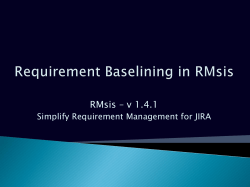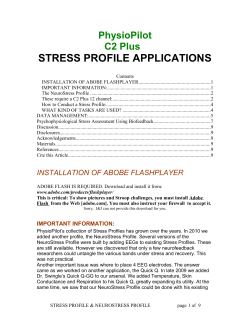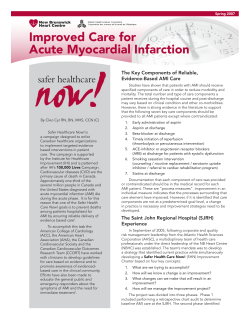
Disease-modifying antirheumatic drugs (DMARDs) for rheumatoid arthritis 1–5
OKA4962 NPS News 2pp 18/9/06 10:02 AM Page 1 Disease-modifying antirheumatic drugs (DMARDs) for rheumatoid arthritis1–5 Drug (Brand name) and dose Contraindications Toxicities that need monitoring Monitoring Hypersensitivity to methotrexate, severe renal or hepatic disease, infection, myelosuppression, neoplastic disorder, alcohol dependence, poor nutrition, immunodeficiency syndrome, peptic ulceration or ulcerative colitis, pregnancy or lactation Myelosuppression, abnormal LFTs, hepatotoxicity, nephrotoxicity, interstitial pneumonitis, pulmonary fibrosis • Hepatitis B and C serology (high-risk patients) and chest X-ray at baseline Hypersensitivity to salicylates or sulfonamide derivatives Myelosuppression, abnormal LFTs • FBC and LFTs at baseline, monthly for the first 3 months, then every 3 months Hypersensitivity to quinolines, retinopathy, pregnancy Retinal toxicity, haemolysis • Ophthalmological review at baseline, then every year Conventional DMARDs Methotrexate (Ledertrexate, Methoblastin) 5–10 mg orally once a week, increase by 2.5–10 mg every 4–6 weeks to maximum 15–25 mg once a week Use with folic acid 5 mg orally once or twice a week (preferably not on day of methotrexate) Sulfasalazine (Pyralin EN, Salazopyrin EN) 500 mg orally daily, increase by 500 mg a week to maximum 3 g daily in divided doses Hydroxychloroquine (Plaquenil) • FBC and LFTs at least monthly if used with leflunomide, or with sulfasalazine and hydroxychloroquine 400–600 mg orally daily in divided doses for 1–3 months (maximum 6 mg/kg/day), then 200–400 mg daily Leflunomide (Arabloc, Arava) 100 mg orally once daily for 3 days, then 10–20 mg once daily Azathioprine (Azahexal, Azamun, Azapin, Imuran, Thioprine) • FBC after 1 week of treatment Hypersensitivity to leflunomide, renal or hepatic impairment, infection, history of toxic epidermal necrolysis or erythema multiforme (e.g. Stevens–Johnson syndrome), myelosuppression, immunodeficiency, pregnancy Myelosuppression, abnormal LFTs, hepatotoxicity, severe skin reactions, interstitial pulmonary disease Hypersensitivity to azathioprine or mercaptopurine, porphyria, neoplastic disorder, infection Myelosuppression, hepatotoxicity, nephrotoxicity Hypersensitivity to cyclosporin, renal impairment, uncontrolled hypertension, malignancy, infection Nephrotoxicity, hypertension, hyperkalaemia, abnormal LFTs 2.5–3 mg/kg orally daily in divided doses for 6 weeks, increase by 0.5–1 mg/kg daily every 1–2 months to maximum 5 mg/kg/day • Hepatitis B and C serology (high-risk patients) at baseline • FBC and LFTs at baseline, monthly for the first 6 months, then every 1–2 months • Urinalysis at baseline • FBC and LFTs at baseline, every 1–2 weeks during dose adjustment, then every 1–3 months 1 mg/kg orally daily, increase by 0.5 mg/kg/day over several weeks to maximum 2.5 mg/kg/day Cyclosporin (Cicloral, Cysporin, Neoral, Sandimmun) • FBC, LFTs and urinalysis at baseline, monthly for the first 6 months, then every 1–2 months • Creatinine and blood pressure at baseline, every 2 weeks until dose is stable, then every 1–3 months • FBC, LFTs and serum potassium at baseline, then periodically Drug (Brand name) and dose Contraindications Toxicities needing monitoring Monitoring Serious toxicity with gold, renal or hepatic impairment, history of myelosuppression or severe haematological disorders, severe or chronic skin conditions, systemic lupus erythematosus Myelosuppression, proteinuria, hepatotoxicity, exfoliative dermatitis, interstitial pneumonitis, pulmonary fibrosis • FBC, LFTs and urinalysis at baseline, every 1–2 weeks for the first 5 months, then monthly As for injectable gold As for injectable gold, but generally less toxic • FBC, LFTs and urinalysis at baseline then every 1–3 months Hypersensitivity to penicillamine, haematological or renal toxicity with penicillamine, systemic lupus erythematosus Myelosuppression, proteinuria, nephrotoxicity, hepatotoxicity • FBC and urinalysis at baseline, every 2 weeks until dose is stable, then every 1–3 months Hypersensitivity to biological DMARD, use of anakinra if hypersensitivity to Escheria coli–derived proteins, concomitant use of TNF-alpha inhibitors and anakinra, previous untreated tuberculosis, septic arthritis (within 12 months), recurrent chest infections or bronchiectasis, infected prosthesis, acute or chronic active hepatitis B or C infection, live vaccination, indwelling urinary catheter, multiple sclerosis or demyelinating disease, malignancy (< 10 years, apart from fully resected basal cell carcinoma > 5 years), congestive heart failure, chronic cutaneous ulceration, pregnancy or lactation Infusion or injection site reactions, serious infection, reactivation of tuberculosis (pulmonary or extrapulmonary), lymphoproliferative disease, demyelinating disease, systemic lupus erythematosus, exacerbation of congestive heart failure, blood dyscrasias, hepatotoxicity • Long-term safety is not yet established; monitor for all rare but serious toxicities Conventional DMARDs (cont’d) Sodium aurothiomalate, injectable gold (Myocrisin) 1–5 mg intramuscularly, increase gradually at weekly intervals to 10 mg, 15 mg, 25 mg and 50 mg once a week, then reduce to every 2–4 weeks Auranofin, oral gold* (Ridaura) 6 mg orally daily, if no response after 6 months increase to maximum 9 mg daily in divided doses • FBC and urinary protein excretion before each injection *Not commonly used in rheumatoid arthritis Penicillamine* (D-Penamine) 125 mg orally daily, increase by 125 mg daily every 6–8 weeks to maximum 1.5 g daily in divided doses *Not commonly used in rheumatoid arthritis Biological DMARDs TNF-alpha inhibitors Etanercept (Enbrel) 50 mg subcutaneously once a week or 25 mg twice a week (3–4 days apart) Infliximab (Remicade) 3mg/kg by intravenous infusion, repeated after 2 and 6 weeks, then every 8 weeks Adalimumab (Humira) 40 mg subcutaneously every 2 weeks May increase to 40 mg once a week in patients not taking methotrexate Anakinra (Kineret) • FBC and LFTs at baseline, monthly for 6 months then every 3–6 months (more often if used with other DMARDs) • Monitor for reactivated tuberculosis during first 2–5 months of treatment • Monitor for signs of heart failure and pulmonary sepsis at every visit Withhold treatment during severe intercurrent infection, malignancy, surgery, congestive heart failure, pregnancy and lactation. IL-1 receptor antagonist • Hepatitis B and C serology and screen for tuberculosis at baseline • Serology if exposure to chickenpox or shingles occurs during treatment 100 mg subcutaneously once daily Abbreviations: FBC = full blood count, IL = interleukin, LFTs = liver function tests, TNF = tumour necrosis factor References 1. Therapeutic Guidelines: Rheumatology, Version 1. 2006. 2. Australian Medicines Handbook, 2006. 3. Lu TY-T, Hill C. Aust Prescr 2006;29:67–70. 4. Scott D, Kingsley G. N Engl J Med 2006;355:704–12. 5. Australian Rheumatology Association. APLAR J Rheumatol 2006;9:123–6. NPS is an independent, non-profit organisation for Quality Use of Medicines, funded by the Australian Government Department of Health and Ageing. October 2006 National Prescribing Service Limited ABN 61 082 034 393 l Level 7/418A Elizabeth Street Surry Hills NSW 2010 l PO Box 1147 Strawberry Hills NSW 2012 Phone: 02 8217 8700 l Fax: 02 9211 7578 l email: info@nps.org.au l web: www.nps.org.au NPSN0371
© Copyright 2025





















